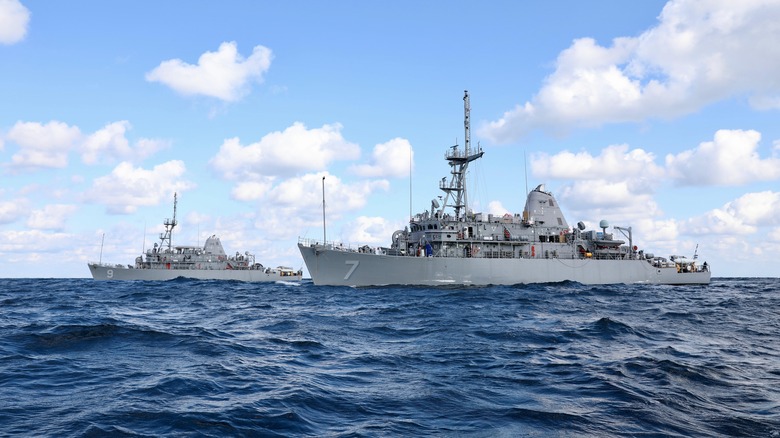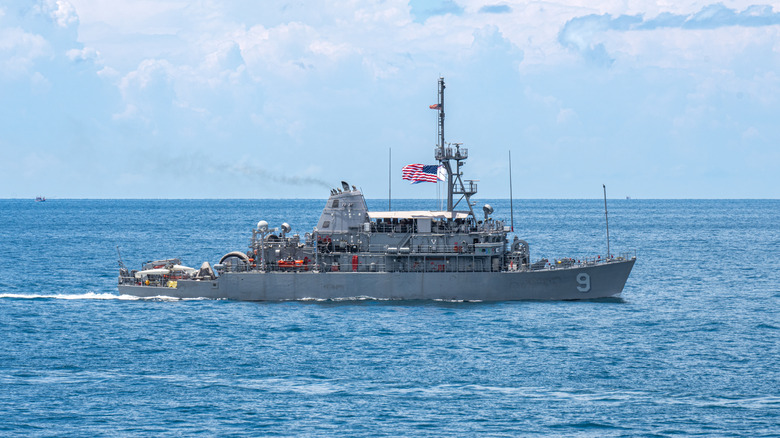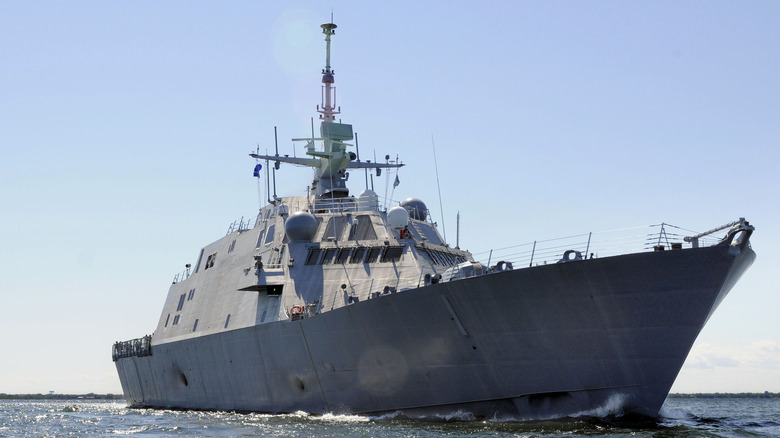Everything You Need To Know About US Navy Minesweepers
The U.S. Navy defines a sea (naval) mine as "a self-contained explosive device placed in water deemed to destroy surface ships or submarines." These mines have played a role in U.S. naval history and operations since the days of the American Revolution. It was during the Revolution when Yale student David Bushnell created the first sea mine and the means to deliver it: America's first submarine, The Turtle. The sea mine was a wooden keg filled with gunpowder and outfitted with a gunlock trigger that would ignite the powder when the mine contacted a vessel. Though no British ships were ever damaged by Bushnell's mine, it ushered in a new era of U.S. naval mine warfare.
Previously, the U.S. Navy had used sloops and the like, but the use of mines spread throughout the world after the Revolution. This forced the U.S. Navy to develop a dedicated class of ship to counteract enemy sea mines: the minesweeper (the ship, not the classic Microsoft game you can play in your Google Browser). The official Mine Sweeping Manual of 1917 states that "Mine sweeping is the act of removing anchored mines from their moorings by dragging the submerged bight of a steel wire through a mine field." Although technology has evolved since the country's first attempt at a minesweeper with the USS Lapwing (AM-1) this basic definition holds true in contemporary times.
Minesweepers locate, target, and destroy mines
The U.S. Navy used minesweepers for decades, but during the Cold War in the 1980s, it was time to update them. This meant adding some ships to the minesweeping force, including minecountermeasure ships (MCMs) and minesweeping helicopters. The MCMs are led by the Avenger MCM-1 class, which the Navy tasked with "finding, classifying and destroying moored and bottom mines."
Stretching 224 feet long and 39 feet wide, the Avenger-class is powered by four diesel engines that power it to travel up to 16 mph. The vessels are manned by eight officers and 76 enlisted members. Each ship is outfitted with two .50-caliber machine guns, two M60.7 62mm machine guns, and two MK19 grenade launchers. This class of ship's bread and butter is found in its anti-mine tools, which consist of an AN/SLQ-48 (V) Mine Neutralization System, an AN/SQQ-32 Mine Hunting Sonar, AN/SPS-55 Surface Radar, AN/SQL-37 (V) Magnetic/Acoustic Influence Minesweeping Gear, an MDG 1701 Marconi Magnetometer Degaussing System, and other mechanical sweep equipment.
How does all of this come together? An MCM utilizes its sonar, video, and detection systems to locate and identify sea mines. Then, it deploys a mine neutralization vehicle (MNV) to disable the mine or uses a drag cable and cutters to sever any mooring lines and detonate them from afar. Even though there are only eight left in service (four in Bahrain and four in Japan), MCM minesweepers have a multitude of tools at their disposal to get the job done.
The US Navy is developing the next generation of minesweepers
The current force of U.S. Navy minesweepers are over 30 years old. Their replacements, Littoral Combat Ships (LCS), have yet to fully come to fruition. Consisting of two variants, the Freedom and the Independence, these LCSs have been in the development phase for years due to a series of issues. For starters, one LCS costs roughly $600 million to build. Compare that to the $274 million Avenger-class, and it's no wonder that the Navy has extended the service of the eight remaining MCMs until 2030 at least.
Though faced with ongoing delays in technological developments such as Raytheon's AN/AQS-20C sonar, the Navy has said it plans to start divesting in the Avengers by fiscal year 2025. To bridge the gap between the rollout of the LCS and the retirement of the Avengers, the Navy spent $78 million to keep the Avengers maintained and in service through at least 2026. Just as drones are changing the way aircraft carriers operate, so too will unmanned submersibles soon change the way minesweepers function. For now though, the Navy is relying on the past to pave the way for the future.


